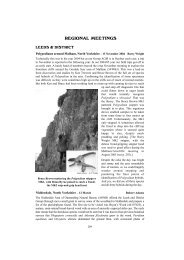Full Contents as pdf File - Natural History Museum
Full Contents as pdf File - Natural History Museum
Full Contents as pdf File - Natural History Museum
Create successful ePaper yourself
Turn your PDF publications into a flip-book with our unique Google optimized e-Paper software.
On Sunday we headed off higher<br />
into the hills to meet Arthur Chater<br />
at the old lead and copper mines e<strong>as</strong>t<br />
of Tal-y-Bont near Esgair Hir and<br />
Esgair Fraith at about 1,500 feet<br />
above sea level (22/7291 to 7391).<br />
This area of Cardiganshire w<strong>as</strong><br />
always considered to be<br />
‘monotonous and unattractive’ by<br />
the old botanists (see Flora of<br />
Cardigan by J.H. Salter, 1935), and<br />
the spot where we parked our cars<br />
w<strong>as</strong> anything but promising – not a<br />
single fern in sight, not even<br />
bracken! Arthur is Vice-county<br />
Recorder for the Botanical Society<br />
of the British Isles and knows the<br />
area very well; I hoped he could<br />
prove the older botanists wrong. In<br />
fact, we soon realised we were in for<br />
a treat but space does not allow me<br />
to do the exploration of this area<br />
justice. Guided by Arthur we saw a<br />
remarkable 31 pteridophyte taxa<br />
here. By some old mine buildings<br />
were Ophioglossum vulgatum,<br />
Botrychium lunaria and Dryopteris<br />
oreades, while on old walls and<br />
shafts we added Asplenium<br />
scolopendrium and A. viride, the<br />
latter apparently found nowhere else<br />
in Cardiganshire. By the side of a<br />
stream on disturbed ground w<strong>as</strong> a<br />
wonderful patch of Equisetum x dycei – a poignant record for those of us who still have<br />
many memories of happy times in the field with the late Jimmy Dyce. In a boggy copse w<strong>as</strong><br />
Dryopteris carthusiana and D. dilatata, possibly with the hybrid D. x deweveri and nearby<br />
on spoil heaps were Lycopodium clavatum, Huperzia selago and Diph<strong>as</strong>i<strong>as</strong>trum alpinum.<br />
Finally, in a small quarry nearby were two plants of Cryptogramma crispa – another rare<br />
fern in this county. The re<strong>as</strong>on for the great diversity in the pteridophytes here is apparently<br />
the mines. Over the centuries different soil types have been exposed, including sufficient<br />
lime in places for strongly calcicolous species.<br />
After a picnic lunch we moved off to a nearby wheel pit where we saw Polystichum<br />
setiferum, P. aculeatum and their hybrid P. x bicknellii, then on to the nearby lake, Llyn<br />
Nantycagl (22/7290 to 7390), some of us via more abandoned buildings to see Cystopteris<br />
fragilis. We paddled and found Isoetes lacustris and probably I. echinospora, <strong>as</strong> well <strong>as</strong> the<br />
somewhat larger hybrid with variably sized meg<strong>as</strong>pores. At this point the party broke up. In<br />
this small, apparently inhospitable area we had beaten the Saturday tally of taxa seen, with<br />
34 recorded.<br />
The grand total for the weekend w<strong>as</strong> 51 different ferns and fern allies. Many thanks to<br />
Barry and Arthur for guiding us, to Barbara Porter for keeping track of what we saw, to the<br />
Neals and Thom<strong>as</strong>es for their hospitality, and finally to Pat Acock for organising such a<br />
superb meeting.<br />
98<br />
photo: A.M. Paul<br />
Arthur Chater explains the distinguishing features<br />
of various Dryopteris species

















